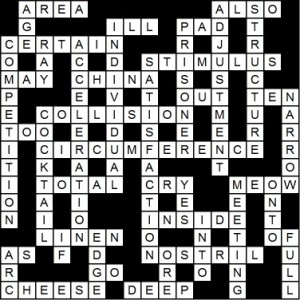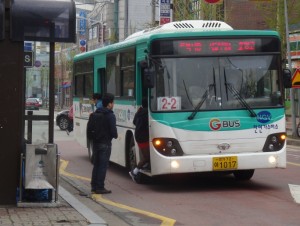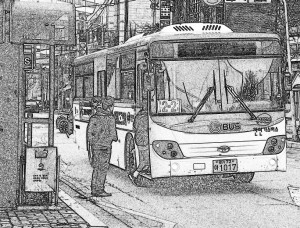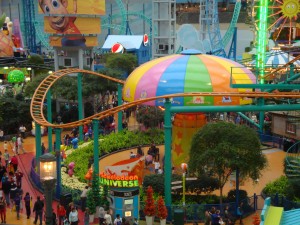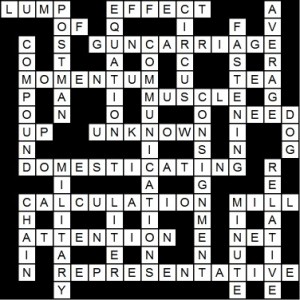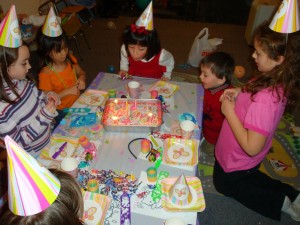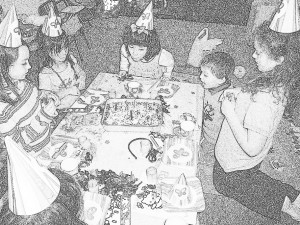Blog Archives
Crossword – Basic Vocabulary 12 (solution)
Writing Assignment: On a Bus (Solution)
1. Where is this picture taken?
This picture is taken at a bus stop.
2. What are the people in the picture doing?
Two of the people in the picture are getting on the bus. One person is getting off the bus.
3. Is this a city bus, or a long-distance bus?
This is a city bus.
4. Where might the people be going?
The people might be going to work or school.
5. What is the first thing you have to do when you get on the bus?
When you get on the bus, the first thing that you have to do is pay the fare.
6. What are the different ways that the fare can be paid?
The fare can be paid with cash. In many buses, you can also pay by swiping a card that has credit available on it. Another option is to buy a pass, especially if you use the bus every day.
7. If you pay with cash, can you get change back if you have big bills?
Some buses can give you change back if you pay with big bills. Other buses will accept only exact change for cash fares. This means that they are unable to give you change back if you use bills that are bigger than the fare.
8. What is a bus pass?
A bus pass is special ticket that allows you unlimited rides within a certain time frame, like a monthly pass, a weekly pass, etc.
9. What kind of discounts are available for bus fares?
Many bus companies have various discounts available: student discounts, senior citizen discounts, or handicapped discounts. If you don’t get a discount, you have to pay full fare.
10. Where can you sit on the bus?
On the bus you can sit in a seat. The seat may be in the front of the bus, at the back of the bus, or in the middle.
11. What can you do if there are no more seats on the bus?
If there are no more seats on the bus, you will have to stand. Holding on to a strap will make it easier for you to ride the bus standing.
12. What can you do if you have to take a bike on the bus?
If you have to take a bike on the bus, some buses will let you put the bus in the back by the rear door. Other buses have a bike rack (on the front of the bus, for example) where you can put the bike.
13. What can you do if you have to take a baby stroller or baby carriage on the bus?
If you have to take a baby stroller or baby carriage on the bus, you can take it on board at the rear door, where there is more space.
14. How can you tell which bus you should get on?
You can tell which bus you should get on by reading the route sign at the front of the bus.
15. How can you tell when your bus is coming?
You can tell when your bus is coming by reading the bus schedule.
16. What happens if you are late for your bus?
If you are late, you will have to run to catch the bus. Otherwise, you will miss your bus.
17. How can you notify the driver that you want to get off at the next stop?
If you want to get off at the next stop, you can let the bus driver know by pulling the communication cord. This notifies the bus driver that someone wants to get off at the next stop.
18. What kind of routes do city buses have?
City buses have routes that go all over the city. They stop at many different places.
19. What kind of routes do long-distance buses have?
Long-distance buses have buses that travel from city to city. They usually do not stop at many different places within a city, but they might make several stops along the route between cities.
20. How is a long-distance bus different from a city bus?
City buses are plainer than long-distance buses. They have seats that are more utilitarian, and their overhead shelves hold more, but they don’t have a separate space for storing luggage. They also have a front door and a rear door. Long-distance buses are usually coach buses, so they are more comfortable, with nicer seats, curtains, individual air controls and lights, and a luggage area under the bus. Coach buses have only a front door, and not a rear door.
Paragraph: Going for a bus ride
One time I had to travel from one city to another. The two cities were about 575 km apart, but I did not have a car. So I had to take the train part of the way (about 450 km), and a bus the rest of the way (about 125 km). After I got off the train, I walked over to the bus and had the driver put my luggage in the storage compartment under the bus. I gave the driver my ticket, and got on board the bus. There were no assigned seats, so I could pick whatever seat I wanted. I found a seat in the middle of the bus, and sat down by the window. I was traveling for Christmas vacation, so I also had some Christmas presents in a carry-on bag, which I did not want to put in the luggage compartment. I put the Christmas presents on the seat next to me. The seats were comfortable. They had a foot rest, and they could recline, so I was set for the long bus ride. We traveled down narrow country roads that wound along farms and fjords, and hugged mountains. Halfway through the bus ride I had to transfer to another bus to get to my destination. Even though the bus was comfortable, it was nice to get up and stretch my legs before continuing on the final leg of my journey. At long last, the bus pulled into the terminal, bringing me home for the holidays.
Writing Assignment: On a Bus
Vocabulary
Bus stop
Door
Rear door
Front door
Seat
Driver
Fare box
Card reader
Communication cord
Transfer
Route
Ticket
Fare
Pass
Schedule
Line
Standing room only
Strap
Blinkers
Vent
Exact change
Bike rack
Catch the bus
Miss the bus
Pay full fare
Discount
City bus
Long-distance bus
Coach bus
1. Where is this picture taken?
2. What are the people in the picture doing?
3. Is this a city bus, or a long-distance bus?
4. Where might the people be going?
5. What is the first thing you have to do when you get on the bus?
6. What are the different ways that the fare can be paid?
7. If you pay with cash, can you get change back if you have big bills?
8. What is a bus pass?
9. What kind of discounts are available for bus fares?
10. Where can you sit on the bus?
11. What can you do if there are no more seats on the bus?
12. What can you do if you have to take a bike on the bus?
13. What can you do if you have to take a baby stroller or baby carriage on the bus?
14. How can you tell which bus you should get on?
15. How can you tell when your bus is coming?
16. What happens if you are late for your bus?
17. How can you notify the driver that you want to get off at the next stop?
18. What kind of routes do city buses have?
19. What kind of routes do long-distance buses have?
20. How is a long-distance bus different from a city bus?
Paragraph: Going for a bus ride
Have you ridden a bus? Was it a city bus, or a long-distance bus? Where did you go? Write a brief paragraph about your bus ride.
Grammar Basics: Unit 38 – There is / There are (Solution)
Exercise. Look at the picture below. Write sentences about this picture using “There is/are…” or “There isn’t/aren’t…” in response to the prompts.
Example:
Any swings? ==> There are swings.
1. There are a lot of people.
2. There isn’t a food stand.
3. There isn’t a horse.
4. There is a roller coaster.
5. There are trees.
6. There aren’t any benches.
7. There is a lamp post.
8. There is a trash can.
9. There are stairs.
10. There isn’t an elevator.
Exercise. Complete the following sentences with there’s / is there / it’s / is it.
Example:
“________ a car with its lights on.” “________ a red Ford?” ==> “There’s a car with its lights on.” “Is it a red Ford?”
1. “There’s a nice hotel in Flagstaff.” “Is it close to the airport?”
2. “Is there a pool at the hotel?” “Yes, it’s an outdoor pool.”
3. We don’t want to rent that apartment. It’s too small.
4. “Is there an English class for beginners on Monday nights?” “Yes, but it’s full. The class on Tuesday is open, though.”
5. I like that restaurant by the mall. It’s got the best pizza I’ve ever tasted.
6. “There’s a spot on your shirt.” “I’ve brushed it off. Is it gone now?”
7. I haven’t heard of that movie. Is it good?
8. “Is there a bank near the hotel?” “Yes, it’s just two blocks away.”
9. “There’s a wallet in lost and found.” “Is it brown?”
10. This ice cream is not very good. It’s too sweet.
Grammar Basics: Unit 38 – There is / There are
When we introduce an item or a topic, we often use the phrase “There is…” (singular form) or “There are…” (plural form).
Pattern (singular form): “There is…” (“There’s…”)
Waiter, there’s a fly in my soup.
There is a beach at the lake.
Question: “Is there…?”
Is there a pet shop at the mall? – Yes, there is.
Is there a library nearby? – No, there isn’t. / No, there’s not.
Negative: “There is not…” / “There isn’t…” / “There’s not…”
I don’t want to go camping at that park – there isn’t any beach there.
Pattern (plural form): “There are…”
There are some apples on the table. Help yourself.
There are five cars waiting in line for the ferry.
Question: “Are there…?”
Are there any eggs left in the fridge? – Yes, there are (three eggs left).
Are there eight days in a week? – No, there are seven (days in a week).
Also: “How many…are there?”
How many months are there in a year? – There are 12 months in a year.
Negative: “There are not…” / “There aren’t…”
Are there any rooms available at this hotel? – No, I’m sorry, there aren’t.
Note: The phrase “There is…” (“There’s…”) is used to introduce an object or a topic. After the introduction, we can use the pronoun “it” to refer to the introduced object or topic: “It is…” (“It’s…”).
There’s a cat sleeping on the porch. It’s white with black spots. (i.e., the cat is white with black spots)
There’s a museum in the city. It’s very famous. (i.e., the museum is famous)
Exercise. Look at the picture below. Write sentences about this picture using “There is/are…” or “There isn’t/aren’t…” in response to the prompts.
Example:
Any swings? ==> There are swings.
1. A lot of people?
2. A food stand?
3. A horse?
4. A roller coaster?
5. Any trees?
6. Any benches?
7. A lamp post?
8. A trash can?
9. Any stairs?
10. An elevator?
Exercise. Complete the following sentences with there’s / is there / it’s / is it.
Example:
“________ a car with its lights on.” “________ a red Ford?” ==> “There’s a car with its lights on.” “Is it a red Ford?”
1. “________ a nice hotel in Flagstaff.” “________ close to the airport?”
2. “________ a pool at the hotel?” “Yes, ________ an outdoor pool.”
3. We don’t want to rent that apartment. ________ too small.
4. “________ an English class for beginners on Monday nights?” “Yes, but ________ full. The class on Tuesday is open, though.”
5. I like that restaurant by the mall. ________ got the best pizza I’ve ever tasted.
6. “________ a spot on your shirt.” “I’ve brushed it off. ________ gone now?”
7. I haven’t heard of that movie. ________ good?
8. “________ a bank near the hotel?” “Yes, ________ just two blocks away.”
9. “________ a wallet in lost and found.” “________ brown?”
10. This ice cream is not very good. ________ too sweet.
Grammar Basics: Unit 37 – Do this…, Don’t do that…, Let’s do… (Solution)
Exercise. Choose the correct verb and complete the following sentences. Make them commands.
Example:
________ the seeds 2 inches apart. (plant) ==> Plant the seeds 2 inches apart.
1. Sit next to me.
2. Write a letter to Aunt Edna.
3. Take two pills after every meal.
4. Please sign on the dotted line.
5. Read the book and write a report on it for next Monday.
6. Please dry the dishes and put them away.
7. Say goodbye to Mrs. Wirth.
8. Slice the vegetables and cook them in boiling water for three minutes.
9. Bring a sack lunch for the field trip tomorrow.
10. Wash your face and brush your teeth before you go to bed.
Exercise. For each of the following sentences, suggest an alternative activity using the phrase “No, let’s…”
Example:
Do you want to watch the late night movie? (go to bed) ==> No, let’s go to bed.
1. Do you want to go camping this year? No, let’s stay at a resort.
2. Do you want to leave now? No, let’s wait a while.
3. Shall we have Chinese for dinner? No, let’s have Italian.
4. Should we tell Bob someone dented his car? No, let’s mind our own business.
5. Would you like to play a game? No, let’s watch a movie.
Exercise. Answer each of the following sentences with either “No, don’t…” or “No, let’s not…”
Example:
Should I turn up the heat? ==> No, don’t turn up the heat.
1. Shall I call for a doctor? No, don’t call for a doctor.
2. Should we leave yet? No, let’s not leave yet.
3. Should we have a big party for Tom’s birthday? No, let’s not have a big party.
4. Should I make you a nice, hot cup of coffee? No, don’t make me a cup of coffee.
5. Should I tell Mr. Smith you broke his window? No, don’t tell Mr. Smith.
6. Shall we go for a walk? No, let’s not go for a walk.
7. Should we take the train? No, let’s not take the train.
8. Should I put this picture in the letter to your mother? No, don’t put that picture in the letter.
9. Shall I shine your shoes, sir? No, don’t shine my shoes.
10. Should we give Sally a puppy for Christmas? No, let’s not give Sally a puppy.
Grammar Basics: Unit 37 – Do this…, Don’t do that…, Let’s do…
For the imperative (command) form, we use the infinitive (base form) of the verb:
Go away! Leave me alone.
Clean up your room and make your bed.
Hurry up – the buss will be here soon.
Eat your vegetables.
Watch out!
For a negative command: Don’t (= Do not) + V (inf.)…
Don’t forget to go to the store.
Do not make any noise – Father is sleeping.
Don’t eat a snack. You’ll spoil your supper.
If you want to do something together with another person, you can make a suggestion: Let’s (= Let us) + V (inf.)…
Let’s take a break. I’m tired.
Let’s go home – this party is boring.
It’s a beautiful day – let’s go for a walk.
For a negative suggestion: Let’s not + V (inf.)…
Let’s not watch TV. I’d rather read a book.
Let’s not go anywhere on vacation this year. Let’s just have a “staycation” at home.
Exercise. Choose the correct verb and complete the following sentences. Make them commands.
Example:
________ the seeds 2 inches apart. (plant) ==> Plant the seeds 2 inches apart.
bring
brush
cook
dry
put
read
say
sign
sit
slice
take
wash
write
write
1. ________ next to me.
2. ________ a letter to Aunt Edna.
3. ________ two pills after every meal.
4. Please ________ on the dotted line.
5. ________ the book and ________ a report on it for next Monday.
6. Please ________ the dishes and ________ them away.
7. ________ goodbye to Mrs. Wirth.
8. ________ the vegetables and ________ them in boiling water for three minutes.
9. ________ a sack lunch for the field trip tomorrow.
10. ________ your face and ________ your teeth before you go to bed.
Exercise. For each of the following sentences, suggest an alternative activity using the phrase “No, let’s…”
Example:
Do you want to watch the late night movie? (go to bed) ==> No, let’s go to bed.
have Italian
mind our own business
stay at a resort
wait a while
watch a movie
1. Do you want to go camping this year?
2. Do you want to leave now?
3. Shall we have Chinese for dinner?
4. Should we tell Bob someone dented his car?
5. Would you like to play a game?
Exercise. Answer each of the following sentences with either “No, don’t…” or “No, let’s not…”
Example:
Should I turn up the heat? ==> No, don’t turn up the heat.
1. Shall I call for a doctor?
2. Should we leave yet?
3. Should we have a big party for Tom’s birthday?
4. Should I make you a nice, hot cup of coffee?
5. Should I tell Mr. Smith you broke his window?
6. Shall we go for a walk?
7. Should we take the train?
8. Should I put this picture in the letter to your mother?
9. Shall I shine your shoes, sir?
10. Should we give Sally a puppy for Christmas?
Writing Assignment: At a Birthday Party (Solution)
1. Where was this picture taken?
This picture was taken at a birthday party.
2. What is on the table?
On the table is a tablecloth, along with paper plates, paper cups, napkins, party favors, noisemakers, candy, and a cake.
3. How is the table decorated?
The table is decorated with a colorful tablecloth and festive paper plates and paper cups.
4. How is the cake decorated?
The cake is decorated with pink and white frosting, sprinkles, and birthday candles.
5. How would the room be decorated for a typical birthday party?
For a typical birthday party, the room would be decorated with balloons, streamers, and confetti.
6. What is the girl at the end of the table doing?
The girl at the end of the table is blowing out the birthday candles.
7. What song is usually sung before the birthday child blows out the candles?
Before the birthday child blows out the candles, the song “Happy Birthday” is typically sung to the birthday child.
8. Which child is the birthday child?
The child at the end of the table blowing out the candles is the birthday child.
9. What are the other children doing?
The other children are watching the birthday child blow out the candles, to see if she blows all the candles out in one breath.
10. What do the children have on their heads?
The children are wearing party hats.
11. What might children eat and drink at a birthday party?
Children might eat cake and ice cream at a birthday party, and they might have punch to drink.
12. What else might children do at a birthday party, besides eating?
Other things that children typically do at a birthday party are singing, playing games, and opening presents, for the birthday child.
13. What kind of games might children play at a birthday party?
There are many different kinds of games that children might play at a birthday party, but the most common ones are “pin the tail on the donkey,” “musical chairs,” and “clothespin drop.”
14. What else might children play with at a birthday party?
The children might play with toys, balloons, or party favors at a birthday party.
15. What do the children bring for the birthday child?
The children each bring a birthday present for the birthday child.
16. What usually accompanies the birthday present?
A birthday card usually accompanies the birthday present.
17. How is a birthday present typically decorated?
A birthday present is typically decorated with wrapping paper, and perhaps ribbons or a bow.
18. What is the polite way for the birthday child to thank the other children for the birthday presents?
The birthday child can thank the other children in person for the presents, but it is considered polite to also send a written thank-you note acknowledging the present.
19. How does the birthday child ask others to come to his birthday party?
The birthday child asks the other children to come to his birthday party by sending them an invitation.
20. How does the birthday child know how many children are going to come to the party?
The birthday child knows how many children are coming to the party by requesting them to RSVP, or respond to the invitation to let the host of the party know whether or not they are coming.
Paragraph: At a Birthday Party
At our house we had a birthday party. There was much to do to prepare for the party. My daughter thought about whom she wanted to invite to her party, and then we sent out invitations. We bought some decorations, and decorated the room with streamers, balloons, and colorful paper cups and plates. I baked a cake and decorated it with pink frosting, sprinkles, and seven colorful candles. When it was party time, the children all came, ready for some birthday fun. Each child got a party hat, party favors, and a noise maker. We played pin the tail on the donkey, musical chairs, and drop the clothespin in the bottle. After the games, it was time to eat. The children sat down at the table, and I lit the candles. The children all sang “Happy Birthday” to my daughter, and after making a wish, she blew out all the candles on her cake. Everybody had cake and ice cream to eat, and punch to drink. After everyone was done eating, it was time for the birthday child to open presents. There were dolls and stuffed toys and crayons and art supplies, and all kinds of things that little girls enjoy. The children all played with the various toys until the party was over. Then their mothers came to pick them up and take them home. Everybody had a wonderful time.
Writing Assignment: At a Birthday Party
Vocabulary
Happy Birthday
cake
frosting
ice cream
present
candle
punch
party favor
party hat
party game
pin the tail on the donkey
musical chairs
clothespin drop
make a wish
birthday spankings
decorations
balloon
streamer
paper plate
paper cup
napkin
plastic ware
confetti
invitation
RSVP
noisemaker
blow out the candles
wrap a present
bow
wrapping paper
birthday card
thank-you note
1. Where was this picture taken?
2. What is on the table?
3. How is the table decorated?
4. How is the cake decorated?
5. How would the room be decorated for a typical birthday party?
6. What is the girl at the end of the table doing?
7. What song is usually sung before the birthday child blows out the candles?
8. Which child is the birthday child?
9. What are the other children doing?
10. What do the children have on their heads?
11. What might children eat and drink at a birthday party?
12. What else might children do at a birthday party, besides eating?
13. What kind of games might children play at a birthday party?
14. What else might children play with at a birthday party?
15. What do the children bring for the birthday child?
16. What usually accompanies the birthday present?
17. How is a birthday present typically decorated?
18. What is the polite way for the birthday child to thank the other children for the birthday presents?
19. How does the birthday child ask others to come to his birthday party?
20. How does the birthday child know how many children are going to come to the party?
Paragraph: At a Birthday Party
Do you celebrate birthdays, either your own, or someone else’s? When was the last time you were at a birthday party? How do you celebrate birthdays? Write a brief paragraph describing a typical birthday party.

